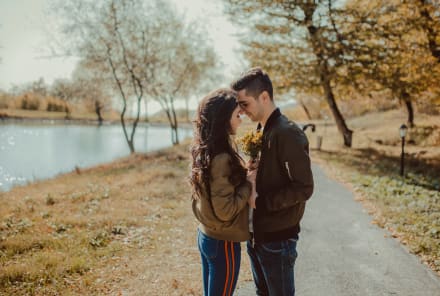Advertisement
10 Tips To Giving Great Yoga Assists

For a beginning teacher or a teacher in training, assisting a yoga class is an invaluable experience. It affords the opportunity to practice observing the students' bodies. You can check and encourage proper alignment without having to worry about leading the class.
It's a great time to refine your physical assisting skills and get comfortable with touching students. It's also the perfect opportunity to prove to a teacher or a studio that you'd one day like to teach there.
However, there are some things about assisting that everyone should know in order to provide the safest and most enjoyable experience for everyone involved.
First, let's talk first about assisting guidelines.
1. Set your intention for the assist.
You're there to make the posture more enjoyable for the student, not to correct them. Yes, you're encouraging proper alignment, but it's for the student's comfort and safety, not because they're "doing it wrong." Assisting (and yoga for that matter) is first and foremost an energetic practice. So if you come at them with a "just get your damn leg straight" attitude, they're going to feel it, whether you utter a word or not. That said, touch is intimate. Treat it as such. You already know that energy is transferred from person to person.
When I was in training, my teacher explained it perfectly. We're all humans (yes, yoga teachers are humans). Occasionally, people become attracted to each other. (Hey, my teacher ended up marrying one of her students.) But if you're vibing on someone, DON'T TOUCH THEM. Just don't. If you've been practicing yoga for any length of time, you know all about the creepy, lingering, breath-on-your-neck assist. Don't be that person.
2. Start at the base of the pose.
Always look at a student's feet first (or whatever the pose's foundation is.) Make sure they're aligned and that the base of the pose is solid. Ground the student using your own body, providing support for the legs and torso, before you move onto the upper body. You always want to adjust from the core of the body before moving on to the periphery.
So for example, if you're going to correct a student's arm in extended side angle pose, use your body to ground the legs, one hand to stabilize the shoulder and the other to move the hand. The last thing to move is the gaze.
If it's an alignment assist, use words first. Sometimes all a student needs is a simple, "turn your heel out." It could be as easy as tapping the floor to show them where you want their foot to be. It's often not even necessary to touch them. If you're just trying to get someone in proper form, try to talk it out first, and then use physical cues as needed.
3. Align THEN deepen.
Deepening assists are meant to bring students to a place they couldn't necessarily access on their own. They're supposed to feel good. If someone's hips aren't square in pigeon, you have no business sitting on their back. Always get the student into proper alignment before you attempt to get them deeper into the pose. A rule of thumb: if a student can't align himself, he probably shouldn't be deepened at all.
4. Use your intuition.
When deepening a student, sync your breath up with theirs. Make sure you're in tune with that student. You should be able to feel the place where you should stop. I'll often just say a simple, "Is this okay?" to be sure. They should not be wriggling beneath your hands and if they can't get a word out, you've probably gone too far. Always lean toward caution with deepening. And when in doubt, leave it out.
It's safe to say that most beginning (and even intermediate) students should not be deepened intensely or often. This also applies to whether to touch a student at all. If you're feeling that for some reason you shouldn't touch someone, don't. Touch is powerful and can illicit different emotions from different people. If you're getting that feeling that someone doesn't want to be touched, there's probably a reason why.
5. When in doubt, leave it out.
If you’re feeling unsure about an assist, the student will know. Always move with intention and purpose. You want the assist to be strong, grounding, and supportive. One of my teachers advises touching students only with the palm of your hands to avoid that weak fingertip feeling that can be unsettling. Move from your own core and make sure that you are as grounded as you want the student to be.
Now, when you're assisting someone else's class...
6. You're the co-pilot.
The teacher is the bus driver. They're ruling the show. Mirror their assisting style. I've assisted teachers who touch every single student. They literally start in the back of the room and give everyone a little lovin'. This makes the job a bit easier, especially when the students expect to be touched, but you still need to use your head and know when, where, and how to do it. I've also assisted teachers who rarely give alignment assists, let alone deepening assists. They simply use verbal cues. It's wise to take a teacher's class before you assist it so you know what to expect.
7. You're there to help.
Look around the room and offer students props if they need them. Make eye contact with the teacher to see if there's anything they'd like. Maybe you can get the lights, turn on the fan, lower the music, open the door, etc. The teacher will appreciate your help and the whole show will flow more smoothly.
8. If there's nothing to be done, stand in the back of the room.
This is actually a (constructive) criticism I got the first time I assisted a class. There's nothing worse than playing the middle school dance wallflower, where people can actually see you doing it. It's fine to be hands off at points during class, just make sure you're not drawing attention to yourself. (You’ll be glad you did.)
9. Honor the class opening and closing.
Where you'll be positioned during the class is up to the discretion of the teacher, but always honor grounding/centering/Om/Namaste, etc. Even though you're not practicing, it's important to show the students that you take the practice seriously by respectfully participating in whatever spiritual aspects the teacher brings to the class. You are there to serve the students, and should take the time to honor that intention in yourself. After all, serving others is the highest calling. That's why we teach Yoga!
10. Enjoy yourself.
Ninty-nine times out of a hundred, a student will be glad you took the time to give them an assist. I almost always love getting a sweet deepening or neck lengthening adjustment. It's been shown that our country as a whole is severely touch-starved, and that a simple pat on the back to say "hey, I'm here" or "you're in a safe place" can be incredibly healing and powerful. People come to yoga to be supported, and it's your job as a teacher (or an assistant) to hold the space for a student to be nurtured.
When your intention for assisting comes from a place of goodness and service, you can't go wrong!
Watch Next
Enjoy some of our favorite clips from classes
Enjoy some of our favorite clips from classes
What Is Meditation?
Mindfulness/Spirituality | Light Watkins
Box Breathing
Mindfulness/Spirituality | Gwen Dittmar
What Breathwork Can Address
Mindfulness/Spirituality | Gwen Dittmar
The 8 Limbs of Yoga - What is Asana?
Yoga | Caley Alyssa
Two Standing Postures to Open Up Tight Hips
Yoga | Caley Alyssa
How Plants Can Optimize Athletic Performance
Nutrition | Rich Roll
What to Eat Before a Workout
Nutrition | Rich Roll
How Ayurveda Helps Us Navigate Modern Life
Nutrition | Sahara Rose
Messages About Love & Relationships
Love & Relationships | Esther Perel
Love Languages
Love & Relationships | Esther Perel

















